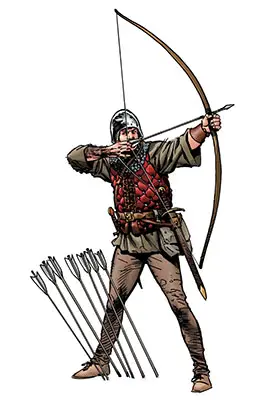Medieval Longbow
One of the most important inventions in warfare was the development of the longbow. It allowed archers to deliver arrows from a greater distance and with greater force than the short bow. It also allowed archers to deliver their arrows at a fairly quick rate. The archers would stand back and shoot arrows into the enemy forces, breaking the line before the cavalry charged.


How Big is a Longbow?
A typical longbow is about as big as the archer using it. They can be around two meters long and the diameter at the center of the wooden shaft of the bow would be around twelve centimeters. The wooden shaft would gradually narrow towards the ends. At the ends, the diameter would be around five centimeters.
Yew was the best wood for longbows and the wood was usually cut in winter. The longbow shaft was cut from the area of the yew tree where the heartwood (the inside part of the tree) and the sapwood (the outer part of the tree) meet. The shaft was then seasoned for three to four years before being used.
The bow also needed a string to shoot the arrow. The string was made from sinew, linen, or hemp. Sinew is made from animal tendons. The archer would take the tendons and pound them with a smooth rock until the tendon began to separate into individual strings. These strings would be wound around each other to increase the strength and then used for a bow string. Often there would be horn tips on the ends of the wooden shaft designed to hold the string.

Draw Weight and Draw Length
The draw weight of a bow is the amount of force an archer needs to exert in order to fire an arrow with the bow. The draw weight of a longbow ranged between thirty-five kilograms to seventy kilograms. The bigger the bow, the bigger the draw weight.
The draw length is the distance that the archer needs to pull the string back to the point of release. Again, a bigger bow has a bigger draw length.
If a longbow has a draw length of fifty centimeters (i.e. you need to pull the longbow string back by fifty centimeters before releasing the arrow), it would require the archer to exert forty-five kilograms of force.

Rate of Fire
The archer would place an arrow in the center of the string and use two fingers (usually on the right hand) and pull back the string until it reached either the archer’s chest or the archer’s chin. The archer would then aim the arrow and let it go.
An arrow had a range of around 320 meters but this depended on the size of the arrowhead. The smaller the arrowhead, the farther the arrow would travel.

An archer would be able to shoot around twelve arrows a minute although some sources have said that this rate was even higher for the most-skilled archers. An archer in the army needed to be able to shoot an arrow hundreds of times during a single battle. In the battle of Agincourt, it has been estimated that over one thousand arrows were fired every second and that after the battle, the ground looked like it was covered in snow from the white fletching of the arrows.

Popularity
The longbow was very popular in England and the use of the longbow was a major factor in winning a number of military encounters. Some of the important battles where longbows played a crucial role were Agincourt, Crecy, and Poitiers. During these three battles, the English were vastly outnumbered by the French but through the use of the longbow, the English won the battles.
The longbow was the weapon of the common man. Few members of royalty used the longbow. In fact, a lot of knights hated the longbow because it allowed a commoner to defeat the mounted nobility. The longbow was very popular in England. In fact, Edward III of England outlawed other sports and demanded that everyone in the country practice the longbow. In fact, everyone in the country who made less than one hundred pence a year had to own a longbow.
One reason for this is that it took a lot of power and practice to shoot an arrow from a longbow. During a battle, the archers didn’t need to shoot just one arrow, they needed to shoot hundreds of arrows. This took a lot of conditioning.




